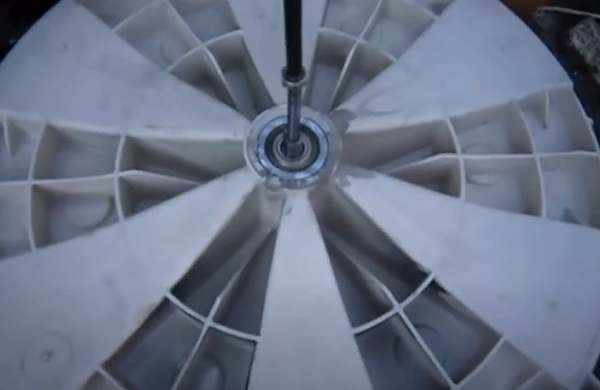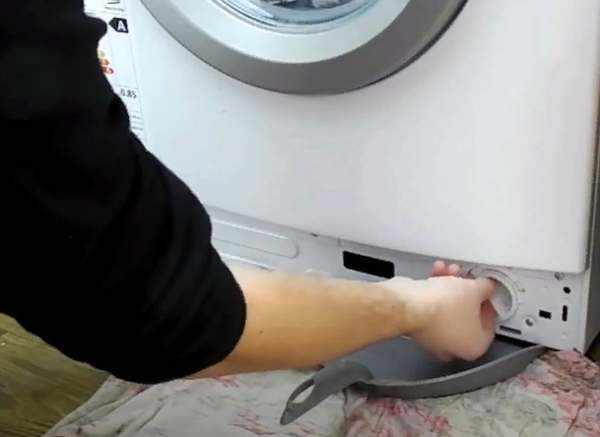A leak under the washing machine can appear for various reasons, both common and those that require the intervention of specialists.
Main Causes of Leaks under the Washing Machine
The operation of the washing machine is associated with the use of water of different temperatures, hardness and detergents, which are chemical compositions with active elements of different nature. As a result of exposure to such an aqueous solution, and even with organic impurities of pollution from linen, it affects the physical properties of metal parts, oil seals, rubber cuffs, tubes and plastic elements.
Malfunction of the bearing assembly
In order for the drum to make rotational movements, its body is rigidly attached to the shaft, which drives the electric motor. The shaft, depending on the design, has one or more bearing assemblies consisting of an oil seal and a bearing.
Most washing machines use sealed deep groove ball bearings and seals to protect them. To make sure that the oil seal is out of order, it is necessary to remove the rear cover and inspect the tank from the side of the bearings. Usually, with a faulty oil seal, water leakage from the washing machine occurs during the spin cycle. The seal (rubber seal) is made of special rubber, silicone rubber or polymer, adjoining the working surface to the shaft, isolating the inner space of the bearing assembly from water. A bushing made of ground bronze or brass alloy is pressed under the seal on the shaft, so the sliding of the cuff edges is almost perfect, which completely prevents liquid from entering the bearing assembly. To protect the gland from aggressive media and to seal the assembly, it is packed with a special grease, usually a silicone base. Lubricants must have a certain degree of moisture and heat resistance, characteristic viscosity and non-aggressiveness in relation to the materials from which the oil seal is made.

In most cases, when the bearing of the washing machine is damaged, you need to call a repair specialist. You can know the nearest repair shop office, or you can find it on the internet. For example, if you are located, say, in California in the Santa Clara area, then the search engine will give you https://tmservicellc.com/ as a query option. If you are in Houston, then the service site of this city.
Crack in the tank
The material for the manufacture of tanks is a special heat-resistant plastic. Over time, the physical properties change and cracks and chips can form on the surface. If a solid object falls between the drum and the tub, it may also be damaged. If water flows from under the washing machine even at the stage of water collection, a violation of the integrity of the tank may be one of the probable reasons for the formation of puddles under the machine.
The best option is to purchase a new tank and install it in a service center. Many craftsmen try to fix the leak with glue and a rubber patch. Using epoxy glue can also have a positive effect, but in both cases it is not for long. Vibration loads and temperature differences will continue the crack formation process, and over time, water will return to the floor. It is also possible to eliminate the crack by spot heating using a soldering station.
Damage to the loading door seal
If foreign objects left in the pockets of things get into the washing drum during washing, they can damage the sealing lip on the door. Also, the reason may be trivial rubber wear or improper closing of the door, which leads to a wrinkle of the cuff. As a result, the tightness of the hatch is broken and water is poured over the hull onto the floor. In any case, check it for integrity, it is not difficult and does not take much time. leaky cuff If a defect is found, the cuff can be repaired in situ using glue and a rubber patch, such as those used to repair inflatable boats. Then it is advisable to turn the cuff so that the sealed part is on top. If the leak cannot be eliminated in this way, the cuff must be replaced with another one.
Drain filter

If water collects in the front of the washing machine on the side of the drain filter, inspect the filter. Sometimes the leak is caused by insufficient tightening of the filter or a violation of the integrity of the rubber gasket. The presence of limescale and various deposits can interfere with the correct seating of the filter in its place, and as a result, water leaks onto the floor. clogged drain filter First, prepare a water container and a cloth. When you unscrew the filter, residual liquid may spill onto the floor. After unscrewing the filter, it is necessary to inspect the rubber gasket for damage. If the gasket has lost its soft rubber properties, you need to buy a new one and make a replacement.
Dispenser and hopper malfunction
It happens that water is poured directly from the powder and liquid detergent compartment. This problem is more common with LG washing machines. The front-loading detergent trays are continuously removed and reinserted. As a result, mechanical wear of the mating surfaces of the tray and the top cover occurs, leading to the formation of a gap. clogged tray When water enters under pressure into the containers of the powder tray, it splashes out and the water is poured out through the slot. If water leaks into the washing machine when drawing water, inspect the tray. Water splashing can also be caused by foreign objects entering the hopper or clogging with detergents. Another reason may be a strong pressure of water entering the dispenser from the inlet valve. You can fix it by adjusting the pressure using the water supply valve. To solve the following problem, you need to remove the tray and clean it from dirt. This is often enough.
Drain pump
The drain pump operates in an intensive mode, pumping tens of liters of water in one wash cycle. Due to high vibration loads and increased pressure on the outlet pipe, cracks can form in the pump casing, sometimes barely noticeable to the naked eye. crack on the drain pump If the pump housing is damaged, the problem is solved by replacing the entire pumping unit. When disassembling and installing, it is necessary to carefully disconnect the branch pipe from the tank, the drain hose and the power contacts, and after replacement, tighten all connections tightly. Clamps should be tightened carefully so that the polymer pipes do not crack. For more information about replacing the pump, see the article: DIY replacement of the drain pump
Inlet and drain hose
If the washing machine is not in use for a long time, and water is collecting under it, a leak may be at the junction of the inlet hose and the fitting. A rubber gasket is installed under the nut, which may lose its properties over time. Leakage can also be caused by insufficient tightening of the connection. end of the inlet hose If water leaks at the hose connection, the first step is to turn off the water supply tap from the water supply system and wait a little to equalize the pressure. Then unscrew the water supply hose and inspect the gasket. It is not difficult to find a new gasket in any plumbing store, since they all come in standard ½ or ¾ sizes.
Conclusion
As you can see, there are many reasons for leaks under the washing machine. You can fix some of them if you know how to do it and are confident in yourself. In other cases, and especially if the device is under warranty, the appropriate specialists should be called.






